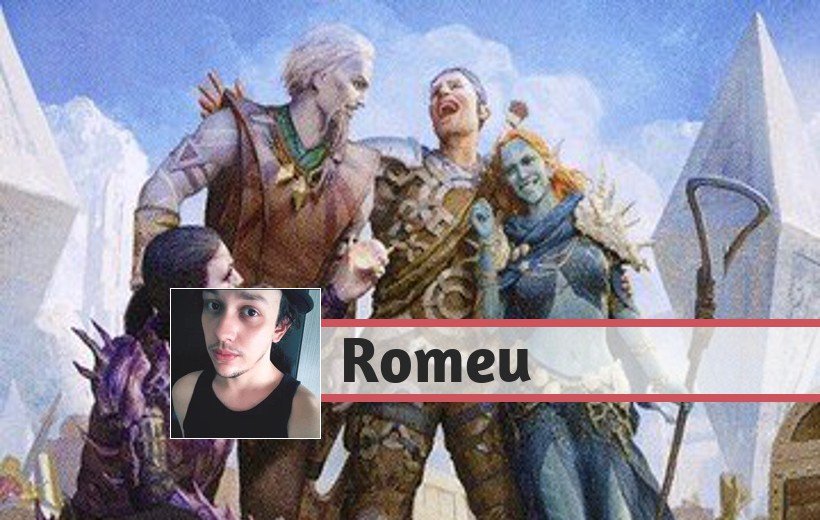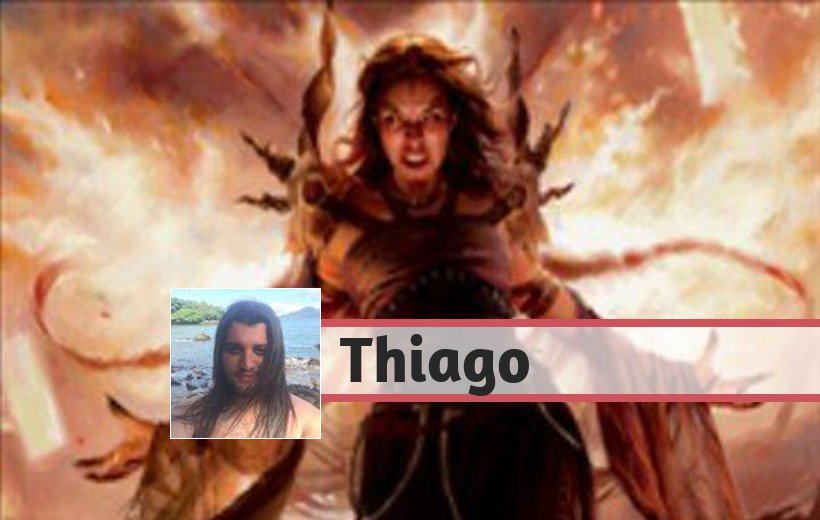One of the most exciting Magic mechanics during the 2021 season was Party, a mechanic which first appeared in 2020 with Zendikar Rising, and consists of getting creatures of specific types into play, as if your goal was to unite a team from classic RPG games, especially adventure-oriented RPGs like Dungeons & Dragons.
Because this mechanic didn't seem to have enough support just with Zendikar Rising, it was believed that future sets would bring support for the mechanic with creatures relevant to the types involved, and possibly with a return to the theme in Adventures in the Forgotten Realms.
Ad
Although Kaldheim does indeed bring very relevant support to the mechanics with Changeling, the other sets lacked support, with a great disappointment from the public coming with the release of Adventures in the Forgotten, where the design team Wizards neglected the mechanic, which seemed perfect for the set, in favor of... Dice rolling.
As a result of the low support (and Throne of Eldraine basically polarizing Standard around its mechanics, leaving little room for newer mechanics to have any space), Party never got around to making any results in Standard events.
However, with the release of Adventures in the Forgotten Realms, the Standard 2022 format was also released in Magic Arena, a format where only the sets that will remain in the Standard after the arrival of Innistrad: Midnight Hunt, that is, the cards that will continue to be legal after the rotation that will carry with it sets that defined the format this year, such as Throne of Eldraine, Ikoria and Theros Beyond Death.
And to my surprise, one of the main Tier 1 decks in the format today, along with Mono-White Aggro and Orzhov Control is Bant Party, a deck that has an average winrate of 65% of the format according to Untapped.gg, making it a great choice in the current format and a possible competitor to the next Standard.
The Deck
As the deck's name already suggests, Bant Party aims to set up your Party with creatures and benefit from creatures that have strong synergies with the mechanics, such as Squad Captain giving indestructible to your creatures, Archpriest of Iona becoming up to a 5/3 Flying for one mana and Linvala, Shield of Sea Gate locking down opponent's creatures or Planeswalkers for an entire turn, plus spells that become super powerful with a full party like Concerted Defense serving as a one-mana Negate and Spoils of Adventure drawing three cards for two mana.
Although Party has not received the necessary support in recent sets, Kaldheim has brought to the deck some essential pieces that make the strategy much more viable: cards like Masked Vandal and The Bears of Littjara allow the archetype to gain access to flexible cards for the required creature types, while Jaspera Sentinel, a rogue-type creature that interacts with Party while facilitating the deck's mana.
The deck has multiple angles to attack, gain value, and different threats that demand a response as your board grows: making plays that offer a full party on turn 4 with Squad Commander is often the aggressive opening, but it also manages to maintain the attrition using Linvala, Shield of Sea Gate, Tazri, Beacon of Unity, Spoils of Adventure and Tajuru Paragon's kicker, which allow the archetype to maintain its game even on longer matchups.
Maindeck

At curve 1, we have Jaspera Sentinel and Archpriest of Iona.
Jaspera Sentinel is, in my view, the card that allows this deck to function even with a fickle manabase, as it creates a relevant body on the board to deal with X/1 creatures, while allowing the deck to use its creatures to add mana as needed, serving as an early game accelerator without necessarily losing its usefulness later, as it can be used to add black or red to Tazri, Beacon of Unity's ability.
Ad
Archpriest of Iona is your ideal one-drop when your hand presents a more aggressive curve, as it will initially be a 2/2 creature for one mana on turn 2, while it will grow according to how you play your other creatures, always being a threat that gives evasion and a power boost to a creature with a full Party.

Linvala, Shield of Sea Gate is an interesting mix of interaction with removals, evasive threat and payoff for a full Party on a single card.
At worst, Linvala, Shield of Sea Gate does a good job as a 3/3 evasive creature for 3 mana that adds a Wizard to your Party and serves as a safety valve against sweepers used by opponents, like Doomskar and Blood in the Snow.
At best, it can lock an opponent's permanent, including Planeswalkers, serving as a soft-lock piece for Control decks looking to win games with Planeswalkers.

To complete the Party quickly, we have creatures that can fill in the gaps left by creatures with specific types.
Tajuru Paragon represents all of a Party's creature types on a single card, is an aggressive body (3/2 for two mana) and has an additional late-game value, where you can pay the Kicker to look at the top six cards of your deck and put into your hand a creature that shares a creature type with it.
Masked Vandal is a pretty mediocre creature compared to the others on the deck, but it's another creature on turn 2 that can fill in the gaps left by other creatures types, and its ability to exile artifacts and enchantments has some important targets in various games such as Paladin Class, Portable Hole, Firja's Retribution, Esika's Chariot, and Ranger Class, and it interacts with the next card on the list.
The Bears of Littjara is probably that card you saw during Kaldheim drafts, but you never paid much attention to whether it could have any use outside sealed formats, especially since it normally wouldn't.
However, in this deck, the card is a real bombshell as it essentially brings into play a 4/4 Changeling that will commonly destroy an opponent's creature or Planeswalker for three mana.
Of course, the opponent can remove the Changeling token before any other ability in the Saga triggers, but the opponent will have spent a resource dealing with a token instead of dealing with another higher-impact creature, which is a virtually favorable trade off, and virtually irrelevant if you have a Masked Vandal in play.

Although most of the creatures in the deck have good synergies with each other and naturally benefit from Party, there are cards that act as the real payoffs.
Squad Commander will usually be the card that the opponent fears you'll play with a full or nearly full Party, as it will not only offer several bodies on the board even in front of a removal, it can also give +1/+0 and indestructible to your creatures during combat, significantly increasing your clock and essentially ending the game if you untap with it.
Ad
Tazri, Beacon of Unity will commonly be a 4/6 creature for one or two mana, setting a clock boost, adding a Warrior to the Party, and possessing a manasink ability that will give you constant card advantage, replenishing your hand with two cards almost every turn and removing the lands from the top of your deck.
Speaking of card advantage, Spoils of Adventure is a mighty card when played for two or three mana, as it offers three cards to the hand and three life with a single card, so that the archetype can replenish its hand after playing its creatures and setting up a full Party.
Finally, this deck that has a need to protect its creatures against some different types of interaction and cannot have certain cards countered, and with Standard 2022 being a Bo1 format, you can't focus on certain responses in the sideboard, and in this case, Concerted Defense serves as a great inexpensive way to interact with the opponent's removals or prevent them from dropping their bombs like Alrund's Epiphany.

The biggest problem with this deck is its manabase, as this list wants to use as many untapped lands as possible, and there aren't enough duals in the format to create a three-color manabase that is consistent for decks looking to play on the aggressive curve.
The deck adopts a playset of each Pathway in the Bant colors, and uses other Pathways (which can generate blue, white or green) to access, if necessary, black and red for Tazri, Beacon of Unity
The problem with Pathways in this list is that you can be severely punished for using them without a plan or idea of what land will be drawn next, as you can use a Hengegate Pathway for white to play Archpriest of Iona and run out of blue mana on turn 3 to cast Linvala, Shield of Sea Gate or The Bears of Littjara

To try to cover up this inconsistency a bit, the deck runs a Temple of the Dragon Queen playset, which basically functions as a five-color Pathway, but which has the severe condition of entering tapped unless you reveal a Dragon from your hand or control a Dragon.
This card synergizes well with Masked Vandal and The Bears of Littjara to enter untapped, but we're talking about eight cards in a deck that has a strong need to play its threats on the right turn, and having land entering tapped can mean a huge problem, especially in hands without Jaspera Sentinel.
Other Options

There is a split in the slots between the lists that use Concerted Defense or opt for a more aggressive stance with Luminarch Aspirant.
There is no consensus on which option is better, and it depends a lot on whether you want to have a more aggressive or flexible plan against spells that win games like Alrund's Epiphany, and if the format were a Bo3, I would definitely play with Luminarch Aspirant on maindeck, and would include Concerted Defense or Negate on the Sideboard.
Ad

Another card used in some number by the lists is Nimble Trapfinder, an evasive threat that can generate a lot of card advantage with a full Party.
Although the card covers the deck's cost 2 well and is in a creature type shared only with Jaspera Sentinel, I feel the card does very little without a full Party and doesn't seem to establish enough pressure to justify its use.

Some lists use one or two copies of Journey to Oblivion as an interaction against creatures, and again, it's possible this card could be better used in Sideboard games, but I feel it's another payoff that does very little in slots that could be invested in better cards.
However, if the Standard 2022 Metagame proves too aggressive in the future, it is possible to include this card in the deck.
Tips & Tricks
• As mentioned earlier, this deck's weakness is its manabase. Therefore, plan well how you intend to play your lands so as not to lack an essential color in the first turns of the game.
• Your deck needs to establish board presence. So, hands with no low-cost creatures or with multiple copies of cards that cost 3 or greater with no way to play them quickly often means a Mulligan.
• That said, it's sometimes necessary to take some risks because this deck doesn't tend to mulligan very well, such as keeping a hand with the necessary mana sources and a one mana creature with no turn 2 play.
• If your starting hand has Archpriest of Iona and Jaspera Sentinel, it's preferable to play Jaspera Sentinel if you have a two-drop, as this way you can play your two mana creature and Archpriest of Iona in turn 2.
• Squad Commander is the card you commonly want to play with a full or nearly full Party, and commonly a card you want to have access to a Concerted Defense or Linvala, Shield of Sea Gate backup, as he manages to establish a pressure that wins the game in very few turns.
• The most common sweeper in the format today is Blood in the Snow, so there's plenty of room for you to plan ahead of it. However, if the opponent is playing white in a non-aggressive deck and uses a Foretell card, consider that it might be a Doomskar.
• Against Control decks, you want to establish a strong board backed by Linvala or Concerted Defense, and for the most part, it's safe to spend the first few turns trying to be the aggressor. Against Aggro, you want to play cards that make the combat favorable, and cards like Masked Vandal blocks well, while Squad Commander does a good job of holding the ground or turning the game against aggressive decks.
• Due to the synergies that this deck has, it's not always good to exchange your creature with your opponent's if it harms the Party.
• Your bad matchup is against decks that uses plenty of removals while managing to establish pressure and threats that blocks your creatures well, like Rakdos Midrange or Izzet Dragons.
• If you have to choose to play a spell like Spoils of Adventure or a creature, it's preferable to choose to increase your board presence.
Ad
• Consider Tazri, Beacon of Unity as a low-cost aggressive creature. Its ability is very useful in Late-Game, but it will usually be the last thing you will be able to do.
• Your topdeck with this list is awful. So use your resources well and try to avoid running out of ways to establish your board and/or ways to draw cards.
Will this deck be competitive enough in the next Standard season?
It's hard to say that for any deck today because we need to know what will come with Innistrad: Midnight Hunt so we can speculate exactly what will be viable and what will not be viable in the format.
What I can say is that this deck needs an essential element to be competitively viable in the next Standard season: a more stable manabase that can sustain the deck's mana requirements.
This means gaining access to better duals that enters untapped or manafixers that fit the deck's theme while helping to fix the mana curve, just like Jaspera Sentinel. Without this, the deck will be too unstable and inconsistent compared to other aggressive decks that may appear, such as Mono-White Aggro or Mono-Green.
Another point that seems necessary for this deck is to have a better two-drop that corresponds to a creature type less present in the deck, such as Wizard or Rogue, since despite the interaction of Masked Vandal with the deck being spectacular, a 1/3 body on turn 2 is not where a deck that is trying to be aggressive wants to be.
Finally, it's not just about what the deck has, but also what other decks might receive: Bant Party has serious problems with Midrange decks that have too many removals, and if these decks become too present in the format, it will be impossible to maintain a Party.
Conclusion
That was my Bant Party deck tech.
It's an extremely fun and strong deck in Standard 2022, and I really hope it can succeed after the rotation as it's one of the most themed and interesting mechanics released in the last year, and multicolored aggressive decks often have a special place in Magic players' hearts.
The Innistrad: Midnight Hunt spoiler season starts this week, on September 2, and from that point on we can speculate which decks will have the most potential in the new Standard and which decks will be limited to casual or lower-ranked games in the format.
Thanks for reading!








— تعليقات0
كن أول من يعلق